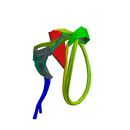
omega-Conotoxin (Conus striatus) (T3D2656)
| Record Information | |||||||||||
|---|---|---|---|---|---|---|---|---|---|---|---|
| Version | 2.0 | ||||||||||
| Creation Date | 2009-07-07 21:54:31 UTC | ||||||||||
| Update Date | 2014-12-24 20:25:48 UTC | ||||||||||
| Accession Number | T3D2656 | ||||||||||
| Identification | |||||||||||
| Common Name | omega-Conotoxin (Conus striatus) | ||||||||||
| Class | Protein | ||||||||||
| Description | Conotoxins are neurotoxic peptides from the venom of the marine cone snail (genus Conus). omega-Conotoxins inhibit N-type voltage-dependent calcium channels and have an analgesic effect. (1) | ||||||||||
| Compound Type |
| ||||||||||
| Protein Structure |  | ||||||||||
| Synonyms |
| ||||||||||
| Chemical Formula | Not Available | ||||||||||
| Average Molecular Mass | 7628.040 g/mol | ||||||||||
| CAS Registry Number | Not Available | ||||||||||
| Sequence | Not Available | ||||||||||
| Chemical Taxonomy | |||||||||||
| Description | Not Available | ||||||||||
| Kingdom | Organic Compounds | ||||||||||
| Super Class | Organic Acids | ||||||||||
| Class | Carboxylic Acids and Derivatives | ||||||||||
| Sub Class | Amino Acids, Peptides, and Analogues | ||||||||||
| Direct Parent | Peptides | ||||||||||
| Alternative Parents | Not Available | ||||||||||
| Substituents | Not Available | ||||||||||
| Molecular Framework | Not Available | ||||||||||
| External Descriptors | Not Available | ||||||||||
| Biological Properties | |||||||||||
| Status | Detected and Not Quantified | ||||||||||
| Origin | Exogenous | ||||||||||
| Cellular Locations | Not Available | ||||||||||
| Biofluid Locations | Not Available | ||||||||||
| Tissue Locations | Not Available | ||||||||||
| Pathways | Not Available | ||||||||||
| Applications | Not Available | ||||||||||
| Biological Roles | Not Available | ||||||||||
| Chemical Roles | Not Available | ||||||||||
| Physical Properties | |||||||||||
| State | Liquid | ||||||||||
| Appearance | Clear solution. | ||||||||||
| Experimental Properties |
| ||||||||||
| Predicted Properties | Not Available | ||||||||||
| Spectra | |||||||||||
| Spectra |
| ||||||||||
| Toxicity Profile | |||||||||||
| Route of Exposure | Injection (sting/bite) (2) | ||||||||||
| Mechanism of Toxicity | omega-Conotoxins act at presynaptic membranes, where they bind inhibit N-type voltage-dependent calcium channels. (1) | ||||||||||
| Metabolism | Free toxin may be removed by opsonization via the reticuloendothelial system (primarily the liver and kidneys) or it may be degraded through cellular internalization via the lysosomes. Lysosomes are membrane-enclosed organelles that contain an array of digestive enzymes, including several proteases. | ||||||||||
| Toxicity Values | Not Available | ||||||||||
| Lethal Dose | Not Available | ||||||||||
| Carcinogenicity (IARC Classification) | No indication of carcinogenicity to humans (not listed by IARC). | ||||||||||
| Uses/Sources | Conotoxins are neurotoxic peptides from the venom of the marine cone snail (genus Conus). (1) | ||||||||||
| Minimum Risk Level | Not Available | ||||||||||
| Health Effects | Conotoxins are neurotoxic. (1) | ||||||||||
| Symptoms | Cone snail stings can cause intense pain, swelling, numbness and tingling. Symptoms can start immediately or can be delayed in onset for days. Severe cases involve muscle paralysis, changes in vision and respiratory failure that can lead to death. (3) | ||||||||||
| Treatment | Not Available | ||||||||||
| Normal Concentrations | |||||||||||
| Not Available | |||||||||||
| Abnormal Concentrations | |||||||||||
| Not Available | |||||||||||
| External Links | |||||||||||
| DrugBank ID | Not Available | ||||||||||
| HMDB ID | Not Available | ||||||||||
| PubChem Compound ID | Not Available | ||||||||||
| ChEMBL ID | Not Available | ||||||||||
| ChemSpider ID | Not Available | ||||||||||
| KEGG ID | Not Available | ||||||||||
| UniProt ID | Q9XZK2 | ||||||||||
| OMIM ID | |||||||||||
| ChEBI ID | Not Available | ||||||||||
| BioCyc ID | Not Available | ||||||||||
| CTD ID | Not Available | ||||||||||
| Stitch ID | Conotoxin, omega- | ||||||||||
| PDB ID | 1FYG | ||||||||||
| ACToR ID | Not Available | ||||||||||
| Wikipedia Link | Not Available | ||||||||||
| References | |||||||||||
| Synthesis Reference | Not Available | ||||||||||
| MSDS | Not Available | ||||||||||
| General References | |||||||||||
| Gene Regulation | |||||||||||
| Up-Regulated Genes | Not Available | ||||||||||
| Down-Regulated Genes | Not Available | ||||||||||
Targets
- General Function:
- Voltage-gated calcium channel activity
- Specific Function:
- Voltage-sensitive calcium channels (VSCC) mediate the entry of calcium ions into excitable cells and are also involved in a variety of calcium-dependent processes, including muscle contraction, hormone or neurotransmitter release, gene expression, cell motility, cell division and cell death. The isoform alpha-1B gives rise to N-type calcium currents. N-type calcium channels belong to the 'high-voltage activated' (HVA) group and are blocked by omega-conotoxin-GVIA (omega-CTx-GVIA) and by omega-agatoxin-IIIA (omega-Aga-IIIA). They are however insensitive to dihydropyridines (DHP), and omega-agatoxin-IVA (omega-Aga-IVA). Calcium channels containing alpha-1B subunit may play a role in directed migration of immature neurons.
- Gene Name:
- CACNA1B
- Uniprot ID:
- Q00975
- Molecular Weight:
- 262493.84 Da
References
- Wikipedia. Conotoxin. Last Updated 2 June 2009. [Link]